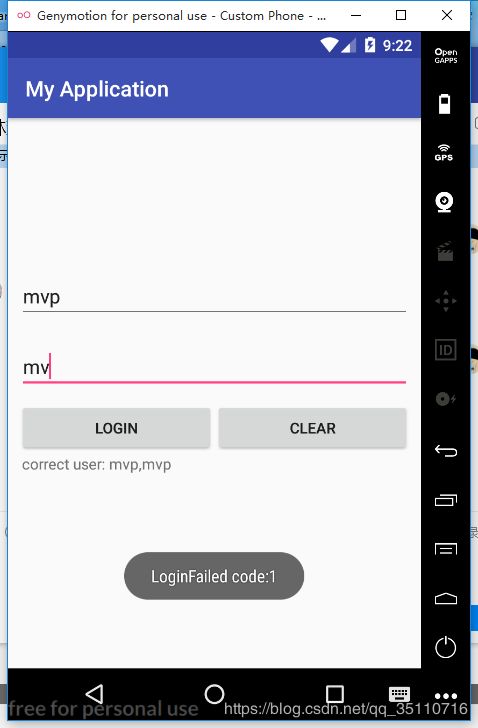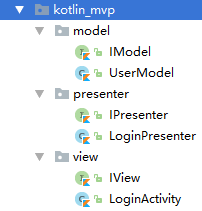Kotlin学习之路(三) kotlin实现简单的MVP模式
Kotlin学习之路(三) kotlin实现简单的MVP模式
本文参考自: https://blog.csdn.net/swust_zeng_zhuo_k/article/details/78760947
前言:由于工作中接触到的新项目中用的是MVP框架,而博主这个刚刚毕业的菜鸟虽然以前也听过这个模式,但是从来没有理清过这个模式M V P之间的关系,所以“事到临头”,只得硬着头皮从小demo开始,找找搭建mvp框架的感觉 。本文作为学习记录。
首先上一张MVP框架的结构图:
M - Model V - View P - Presenter
MVP模式的核心思想:
MVP把Activity中的UI逻辑抽象成View接口,把业务逻辑抽象成Presenter接口,Model类还是原来的Model。
理论的东西,说实话我还是不太明白,暂时只明白了这三个模块间如何进行交互,大家可以去看原文。所以就直奔主题,用Kotlin来实现简单的mvp模式。
(链接原文) 项目结构看起来像是这个样子的,MVP的分层还是很清晰的。我的习惯是先按模块分Package,在模块下面再去创建model、view、presenter的子Package,当然也可以用model、view、presenter作为顶级的Package,然后把所有的模块的model、view、presenter类都到这三个顶级Package中,就好像有人喜欢把项目里所有的Activity、Fragment、Adapter都放在一起一样。
model包下的文件:
IModel.kt (Model层的接口文件)
package com.example.liu.myapplication.kotlin_mvp.model
interface IModel {
/**
* 判断用户输入的用户名密码是否正确
*/
fun checkUserValidity(name: String,password: String): Int
}
UserModel.kt (Model层接口的实现类)
package com.example.liu.myapplication.kotlin_mvp.model
class UserModel(var mName: String,var mPwd: String): IModel {
override fun checkUserValidity(name: String, password: String): Int {
if (mName == name && mPwd == password) {
return 0 //用户名密码正确返回0
}
return 1
}
}
presenter包下的文件:
IPresenter.kt (Presenter层的接口)
package com.example.liu.myapplication.kotlin_mvp.presenter
interface IPresenter {
/**
* 通知View层清空输入框
*/
fun clearText()
/**
* 将登录结果传递给View层
*/
fun login(name: String, pwd: String)
/**
* 通知view层控制ProgressBar的可见性
*/
fun setProgressVisibility(visibility: Int)
}
LoginPresenter.kt (Presenter层接口的实现类,处理业务逻辑)
package com.example.liu.myapplication.kotlin_mvp.presenter
import android.os.Handler
import android.os.Looper
import com.example.liu.myapplication.kotlin_mvp.model.IModel
import com.example.liu.myapplication.kotlin_mvp.model.UserModel
import com.example.liu.myapplication.kotlin_mvp.view.IView
class LoginPresenter(private var loginView: IView): IPresenter {
private var handler: Handler
private lateinit var user: IModel
init {
initUser()
handler = Handler(Looper.getMainLooper())
}
private fun initUser() {
//创建一个用户
user = UserModel("mvp","mvp")
}
override fun clearText() {
loginView.onClearText()
}
override fun login(name: String, pwd: String) {
var isLoginSuccess = true
//判断用户输入的用户名密码是否正确
val code = user.checkUserValidity(name,pwd)
if (code != 0) isLoginSuccess = false
val result = isLoginSuccess
//模拟网络耗时操作
handler.postDelayed({ loginView.onLoginResult(result,code) },1000)
}
override fun setProgressVisibility(visibility: Int) {
loginView.onSetProgressVisibility(visibility)
}
}
这个地方要说下IPresenter的实现类,我个人的理解是,presenter作为 Model层和 View层的桥梁,要同时持有这两个接口的引用(不知道这么说对不对,如有不对敬请指出)。
view包下的文件:
IView.kt(View层的接口文件)
package com.example.liu.myapplication.kotlin_mvp.view
interface IView {
/**
* 清空输入框
*/
fun onClearText()
/**
* 登录后的处理
*/
fun onLoginResult(result: Boolean, code: Int)
/**
* 设置进度条的可见性
*/
fun onSetProgressVisibility(visibility: Int)
}
LoginActivity.kt (View层接口的实现类,仅控制视图相关的处理)
package com.example.liu.myapplication.kotlin_mvp.view
import android.os.Bundle
import android.support.v7.app.AppCompatActivity
import android.view.View
import android.widget.ProgressBar
import android.widget.Toast
import com.example.liu.myapplication.R
import com.example.liu.myapplication.kotlin_mvp.presenter.IPresenter
import com.example.liu.myapplication.kotlin_mvp.presenter.LoginPresenter
import kotlinx.android.synthetic.main.activity_my_mvp.*
class LoginActivity : AppCompatActivity(), IView, View.OnClickListener {
private lateinit var loginPresenter: IPresenter
override fun onCreate(savedInstanceState: Bundle?) {
super.onCreate(savedInstanceState)
setContentView(R.layout.activity_my_mvp)
loginPresenter = LoginPresenter(this)
progress_bar.visibility = View.INVISIBLE
btn_login.setOnClickListener(this)
btn_clear.setOnClickListener(this)
}
override fun onClearText() {
et_name.setText("")
et_pwd.setText("")
}
override fun onLoginResult(result: Boolean, code: Int) {
btn_login.isEnabled = true
btn_clear.isEnabled = true
loginPresenter.setProgressVisibility(View.INVISIBLE)
if (result) {
Toast.makeText(this@LoginActivity, "LoginSuccess code:$code", Toast.LENGTH_SHORT).show()
} else {
Toast.makeText(this@LoginActivity, "LoginFailed code:$code", Toast.LENGTH_SHORT).show()
}
}
override fun onSetProgressVisibility(visibility: Int) {
progress_bar.visibility = visibility
}
override fun onClick(v: View?) {
when (v?.id) {
//登录按钮
R.id.btn_login -> {
btn_login.isEnabled = false
btn_clear.isEnabled = false
progress_bar.visibility = View.VISIBLE
loginPresenter.login(et_name.text.toString(), et_pwd.text.toString())
}
//清空按钮
R.id.btn_clear -> loginPresenter.clearText()
else -> { }
}
}
}
差点把布局文件忘记了,不过这个布局文件写的很简单:
activity_my_mvp.xml :
<LinearLayout xmlns:android="http://schemas.android.com/apk/res/android"
xmlns:app="http://schemas.android.com/apk/res-auto"
xmlns:tools="http://schemas.android.com/tools"
android:layout_width="match_parent"
android:layout_height="match_parent"
android:orientation="vertical"
android:gravity="center"
tools:context="com.example.liu.myapplication.view.MyMvpActivity">
<EditText
android:id="@+id/et_name"
android:layout_width="match_parent"
android:layout_height="wrap_content"
android:layout_margin="10dp"
android:hint="type username"/>
<EditText
android:id="@+id/et_pwd"
android:layout_width="match_parent"
android:layout_height="wrap_content"
android:layout_margin="10dp"
android:hint="type password"/>
<LinearLayout
android:layout_width="match_parent"
android:layout_height="wrap_content"
android:layout_marginLeft="10dp"
android:layout_marginRight="10dp">
<Button
android:id="@+id/btn_login"
android:layout_weight="1"
android:layout_width="0dp"
android:layout_height="wrap_content"
android:text="login"/>
<Button
android:id="@+id/btn_clear"
android:layout_weight="1"
android:layout_width="0dp"
android:layout_height="wrap_content"
android:text="clear"/>
LinearLayout>
<TextView
android:layout_gravity="left"
android:layout_marginLeft="13dp"
android:layout_width="wrap_content"
android:layout_height="wrap_content"
android:text="correct user: mvp,mvp"/>
<ProgressBar
android:id="@+id/progress_bar"
android:layout_width="wrap_content"
android:layout_height="wrap_content" />
LinearLayout>
总结: 个人觉得,mvp模式刚开始写感觉,啊好复杂啊,这么多代码。但是在用 java 和 kotlin 反复敲过几遍以后,发现,啊,这个模式这么清晰的吗,我以后一定要把这个理解的更加透彻一些… 好吧,感觉自己写博客的逻辑太混乱了,希望慢慢可以进步。
如果这篇博客哪里有错误的地方,希望各位可以指出,谢谢。


